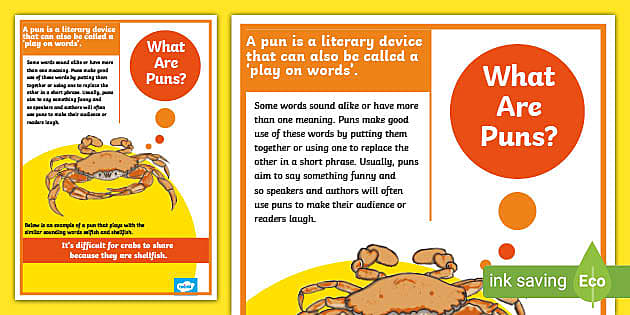A pun is a form of wordplay. It exploits multiple meanings of a term or similar-sounding words.
Puns are everywhere in our daily conversations, literature, and even in advertisements. They add a layer of humor and wit to our language. Understanding puns can enhance your communication skills, making your conversations more engaging. This blog post will unravel the concept of puns, giving you a clear picture of how they work.
It will also explore the different types of puns and their usage in various contexts. Whether you’re a language enthusiast or just someone who enjoys a good laugh, this guide will help you appreciate the cleverness behind puns. Let’s dive into the fascinating world of puns!

Credit: www.twinkl.com.cn
Introduction To Puns
A pun is a form of wordplay. It uses words that have multiple meanings or sound alike. Puns create humor or a joke. They are fun and can make people laugh. A good pun is clever and witty.
Wordplay is important in language. It helps with creativity and thinking. Using puns can make conversations more interesting. They also help with learning new words and meanings.
Puns can be used in writing and speaking. They add fun and enjoyment. People of all ages can enjoy a good pun.
History Of Puns
Puns are a form of wordplay that exploits multiple meanings of a term or similar-sounding words. Originating in ancient times, they have been used in literature and everyday conversation to create humor.
Ancient Origins
Puns have a long history. They were used in ancient times. The ancient Egyptians loved puns. They even used them in their hieroglyphs. Greeks and Romans also enjoyed puns. They used puns in their plays and writings.
Evolution Over Time
Puns evolved over time. During the Middle Ages, puns were popular in literature. Shakespeare used puns in his plays. He made them famous. Today, puns are a part of daily life. People enjoy them in jokes and conversations.
Types Of Puns
Homophonic puns use words that sound the same but have different meanings. For example, “I used to be a baker, but I couldn’t make enough dough.” Here, “dough” means both money and the mixture for bread. These puns are funny because of the double meaning. They make you think and laugh at the same time.
Homographic puns use words that are spelled the same but have different meanings. For example, “I used to be a banker but I lost interest.” Here, “interest” means both curiosity and money earned from savings. These puns play with the different meanings of the same word. They are clever and fun to figure out.
Famous Puns In Literature
Shakespeare loved puns. In his plays, he used many. For example, in “Romeo and Juliet,” Mercutio says, “Ask for me tomorrow, and you shall find me a grave man.” The word “grave” here is a pun. It means both serious and a place to be buried. Shakespeare’s puns add humor and depth. They make his plays more fun.
Many modern writers also use puns. They make readers smile. For instance, in “The Hitchhiker’s Guide to the Galaxy,” Douglas Adams wrote, “You can tune a guitar, but you can’t tuna fish. Unless, of course, you play bass.” This pun is funny. It plays with the words “tune” and “tuna.” Puns can be clever and witty. They show the writer’s skill.
Puns In Popular Culture
Puns are often used in movies and TV shows to make people laugh. Funny wordplay can make a scene more memorable. Characters might use puns in their dialogue. Sometimes, a movie title itself is a pun, making it interesting.
For example, in the movie “Finding Nemo,” the character named Gill is a type of fish part. This is a clever pun. TV shows like “The Simpsons” and “Friends” are also known for using puns. These puns make the shows more fun to watch.
Advertisements use puns to catch your attention. A clever pun can make an ad more memorable. For instance, a bakery might say, “Our bread is on the rise.” This pun uses the double meaning of “rise.”
Puns make ads funny and easy to remember. They help brands stand out. People like ads that make them smile. So, puns are a great tool in advertising.
The Psychology Of Puns
Puns play tricks on the brain. They make words have two meanings. This confuses the mind for a second. Our brains love solving puzzles. So, we feel happy when we get the joke. This makes puns fun and interesting. They also help us think creatively.
Humor comes from surprise. Puns give us this surprise. They make us expect one thing but show us another. This is why puns are funny. They break our expectations. This makes us laugh. It feels good to find the hidden meaning. Humor connects people. It makes us feel close to each other.
Creating Your Own Puns
A pun is a humorous play on words. It uses similar sounds or multiple meanings to create a joke. Creating your own puns can be a fun way to engage others and show your creativity.
Techniques And Tips
Wordplay is key. Start with a simple word. Think of other words that sound like it. Swap them in your sentence. For example, “lettuce” and “let us.” You can say, “Lettuce begin our journey.”
Use homophones. These are words that sound the same but have different meanings. For example, “pair” and “pear.” Say, “I bought a new pair of shoes and a juicy pear.”
Try homonyms. These are words that are spelled the same but have different meanings. For example, “bark” (dog sound) and “bark” (tree covering). Say, “The dog’s bark is louder than the tree’s bark.”
Common Pitfalls
Don’t overthink it. Puns should be simple. If it takes too long to understand, it might not be funny.
Avoid using complex words. Keep your audience in mind. Non-native speakers might not get it.
Be aware of cultural differences. Some puns might not translate well into other languages.
Don’t force a pun into every sentence. Use them sparingly for the best effect.
Puns In Different Languages
Puns are fun. They play with words and sounds. In different cultures, puns can be quite different. Some languages have more puns. Others have fewer. Cultural context matters a lot. A pun that is funny in one culture might not be funny in another. This is because puns often rely on specific cultural knowledge.
Translating puns is hard. Words have different meanings in different languages. A pun in English might not work in Spanish. This is because the words sound different. Some puns get lost in translation. The humor can disappear. Translators often need to be very creative. They must find a way to keep the joke alive. This can be a big challenge.
The Impact Of Puns
Puns can make people laugh. Laughter brings people closer. Telling puns at a party can start conversations. People remember funny moments. This makes you more memorable. Puns can also break the ice. They ease tension in groups. Everyone enjoys a good laugh.
Puns play with words. They teach kids about language. Kids learn new words. They understand wordplay. Puns make learning fun. Teachers use puns in class. It keeps students engaged. They look forward to lessons. Puns help with creative thinking. Kids think in new ways. This helps in other subjects too.

Credit: www.youtube.com
Criticism Of Puns
Many people find puns annoying. They feel puns are too simple. Some say puns lack creativity. Others think puns are childish. A lot of people think puns are not funny. Puns can sometimes be confusing. Misunderstanding can happen due to wordplay.
Puns can be clever. They make people think. Puns play with words in a fun way. Some people enjoy the challenge. Puns can be a great way to break the ice. They bring smiles to many faces. Clever wordplay shows intelligence.

Credit: medium.com
Frequently Asked Questions
What Is A Pun?
A pun is a joke. It uses words with multiple meanings or similar sounds.
Why Do People Use Puns?
People use puns to make others laugh. Puns can be clever and fun.
Can Puns Be Used In Writing?
Yes, puns can be used in writing. They add humor to text.
Are Puns Considered Jokes?
Yes, puns are considered a type of joke. They play with language.
How Do Puns Work?
Puns work by using words with double meanings. Or words that sound alike.
Are Puns Easy To Understand?
Sometimes puns are easy to understand. Other times, they can be tricky.
Do Puns Have To Be Funny?
Not always, but puns are usually meant to be funny.
Can Puns Be Used In Conversations?
Yes, puns are often used in conversations. They make talking fun.
What Is A Common Type Of Pun?
A common type of pun is a homophonic pun. It uses words that sound the same.
Are Puns Used In Different Languages?
Yes, puns exist in many languages. They use wordplay unique to each language.
Conclusion
Puns add humor and creativity to language. They make conversations lively. Even simple puns can bring smiles. Understanding puns improves your English skills. It helps in appreciating jokes better. Try using puns in daily talks. You’ll notice the difference. People will enjoy your wit.
Remember, puns are fun. Happy punning!


Comments